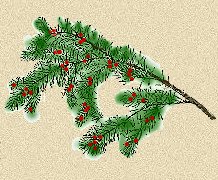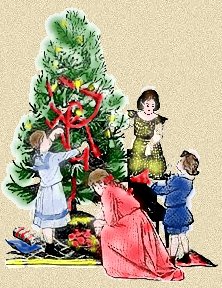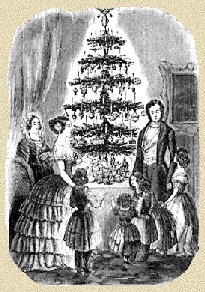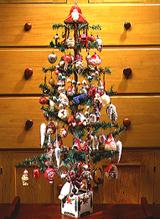 Long before the spread of Christianity, pagans clung firmly to the belief that
the forests would turn green in spring only if people paid homage to the
evergreen throughout the winter. Evergreens, they were convinced, contained
mystical powers that enabled the tree to stay green year-round. Unable to
persuade the people of northern Europe otherwise, Christian missionaries
adopted the practice of bringing evergreens indoors in winter.
Long before the spread of Christianity, pagans clung firmly to the belief that
the forests would turn green in spring only if people paid homage to the
evergreen throughout the winter. Evergreens, they were convinced, contained
mystical powers that enabled the tree to stay green year-round. Unable to
persuade the people of northern Europe otherwise, Christian missionaries
adopted the practice of bringing evergreens indoors in winter.
"The fact that December 25 was chosen [to celebrate Christ's birth]," explains
historian Francis Weismer, "does not seem to rest so much on historical
findings as in the desire to replace the popular pagan celebration of the
winter solstice by the festivities of a truly Christian holiday."

Among the most popular of the early Christian ceremonies were plays written by
the clergy and performed on church steps to teach townspeople the Bible. One of
the most popular of these plays was the story of Adam and Eve and the Forbidden
Fruit. Since fruit trees were barren in the North at Christmastime, the actors
represented the Tree of Paradise in the Garden of Eden by tying apples,
representing Original Sin, to evergreen boughs.
The custom of decorating evergreens with apples, and, as time progressed, with
candles, flowers, religious ornaments, and candy and cookies, grew into a
Christmas tradition in Germany in the 1500's. It is believed that Martin
Luther, the Protestant reformer, was the first to light a Christmas tree with
candles. While coming home one dark winter's night near Christmas, he was
struck with the beauty of the starlight shining through the branches of a small
fir tree outside his home. He duplicated the starlight by using small candles
attached to the branches of his indoor Christmas tree.

In England, putting up a tree was a privilege reserved for royalty from the
time of their introduction to the country around 1700 until the mid-19th
century, when the German-born Prince Albert (1819-1861) gained Queen Victoria's
permission for her subjects to display and decorate evergreens in their homes.
In America, early German settlers carried on their homeland tradition of
decorating evergreens for Christmas, although the practice did not spread until
the 19th century. Even then, many sects, including Puritans, Methodists,
Quakers, Amish, Presbyterians, and Baptists, condemned the celebration for its
pagan roots. It was not until the end of the 19th century that the decorated
Christmas tree achieved widespread acceptance.
Through the years many different things were used to decorate Christmas trees.
As the world moved into the 1900's, many trees were decorated with strings of
popcorn, homemade cards and pictures, cotton to look like snow, candy in all
shapes and sizes, and occasionally, fancy store made glass balls and hand blown
glass figurines. Candles were sometimes used, but often caused devastating
fires, and many different types of candle holders were devised to try to
prevent tree fires. Electric tree lights were first used just 3 years after
Thomas Edison has his first mass public demonstration of electric lights back
in 1879. The early Christmas tree lights were handmade and quite expensive.

Before evergreen trees were planted and harvested as cash crops, forests were
ravaged in a rush to gather trees for Christmas. As a result, Theodore
Roosevelt -- the first American President seriously concerned with the
conservation of our natural resources -- encouraged the use of artificial
trees.
Until the First World War, Americans imported feather trees from Germany. The
feathers were dyed green and attached to stiff wire limbs, which were inserted
into a center post. Artificial berries and candleholders appeared on some
versions. Most of the earliest artificial trees were less than three feet tall
and were intended to be placed on tables. While neither as full nor as
realistic as today's artificial trees, these older models are eagerly sought by
collectors of Christmas ornaments as a means of displaying antique decorations.